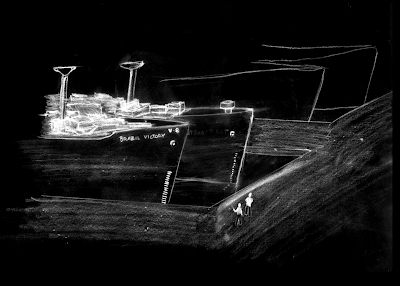

There isn't really any doubt that the invention of the shipping container revolutionized the structure of the entire global market as we know it. Before the creation of this simple box, the shipping industry was fairly inefficient: cargo, upon arrival at the waterfront, was lifted aboard the ship in no particular order, then sorted and loaded. In theory, they were sorted meaningfully, with the goods that would be unloaded first the last loaded, but there was no real standard procedure being used.

Furthermore, the loading and unloading a ship could take hours, with loose goods mixed in with crates, barrels, and sacks needing to be arranged perfectly to avoid an excess of shifting during the boat's trip. This process would not only lose money for the ship owners, but for other transportation companies, such as drivers who had to wait for their cargo to be removed, dumped on deck, sorted, loaded off the boat via a crane, and loaded into his truck before being able to depart.

By the 50s, it was becoming clear to those in the industry that the system might be grossly expensive and inefficient. Enter Malcom McLean, trucking magnate.

(Image courtesy of American Shipper's Florida Caribbean Connection)
Malcom McLean, the owner and founder of McLean Shipping Co., was always looking to save costs at every turn and eliminate as much inefficiency as possible and for him, the loading time at the port was the problem to be solved.
At first, he had intended to use boats specially designed to have trucks drive onto them, but he very quickly realized that this led to wasted space that could be filled with more cargo. He then began to experiment with the idea of simply removing the trucks' containers and placing them on the ship.
He wasn't the first to think of that sort of concept; boats had been carrying railroad cars between the United States and Cuba for several decades, but McLean was the first to make great success of these interchangeable cargo boxes. The idea took the shipping industry by storm.
Following several decades of lawsuits, takeovers, committees and debates, McLean's original metal box design had undergone the process of Containerization, or the standardization of the container system, with the ISO. All containers, from this point forward, were to be more or less the same, allowing for interchangeability between several modes of transport.
As was previously stated, this genuinely revolutionized the shipping industry. The ability to quickly, with the assistance of enormous cranes and minimal manpower, load a crate off of a truck straight onto a cargo ship in Boston which could then be sailed off to Rotterdam before being loaded onto a train and sent to Zurich without ever having to unload anything for an extremely cheap cost was- and is- a boon to almost all industries.
But it has its downside. In the previous decade or so, a fairly sizable shipping imbalance has developed on a global scale: to simplify a complicated scenario, China and Hong Kong are exporting more than they are importing, and it appears to be cheaper for them to make new shipping containers than to pay to ship the empty containers back. This leads to a huge surplus of empty shipping containers- with some estimates of as many as 700,000 surplus containers in the United States in 2005.
Inevitably, people began to take note of the containers- and apparently, it occurred to someone that a container is, at its essence, a pre-made room.
From this realization came the Container City complex.
Container City can be found on Trinity Buoy Wharf in London, located at the confluence of Bow Creek and the Thames, which is a site currently leased by Urban Space Management with the intent to develop it as a cultural and artistic centre. It features London's only lighthouse (not currently functional, though it is home to Longplayer, a fascinating, albeit irrelevant millennial performance piece) and has a long history as one of the main buoy maintenance and testing sites for the London area. Though it is a wharf, it appears to have never been used for a significant amount of shipping.
The 'City' was designed by local architects Nicolas Lacey and Partners (a humorously difficult architect to find- an article from 1994 in The Independent is centered on his lack of public recognition), and was organized by Urban Space Management. Container City I, built in 2001 (with an additional floor added later) is a collection of living/studio spaces and Container City II is completely studio space. The original building was designed without the explicit awareness that it would be popular among the artistic community, but when it quickly found acceptance with artists it would appear that USM changed their tune slightly and began to market the complex as a space for artists. In fact, it may be questioned whether their intent to turn the Wharf into an artistic center was the plan all along, but this is mere conjecture.
More than anything else, it can be said that the more significant driving force behind these buildings is, of course, the construction system itself. To understand these buildings, one must understand the basic design concepts that emerge from the design of the containers.
The containers have monocoque or unibody structure- a sturdy metal frame with very thin cladding providing a "skin". This structure is usually waterproof (or waterproof-able) and is extremely hardy- after all, it needs to be able to survive trips out on the ocean.
The system of connections used to ensure the containers don't regularly go tumbling into the sea is relatively simple and entirely standardized- all shipping containers, to comply with the ISO standards, must have identical (or at least, functionally identical) connecting joints referred to ascorner castings.
These corner castings are designed to work along with a mechanism known as a twist lock, the simple and effective standard for the connection of the shipping containers. This system is exceptionally sturdy (again, it is a requirement that the connectors be able to withstand rough weather at sea).
(Note: While the Container City complex, being a permanent installation, did not rely solely on this system of connection (the containers were welded together), the construction system that has since ballooned in popularity often relies solely on them to create temporary buildings. Furthermore, it is possible that Container City used these connectors to ensure the units were aligned before welding occurred. For simplicity's sake, it will be assumed that the connecting units were used.)
Using the simple principles set forth by the basic design of the container, several "rules of design" may be developed for Container City and other projects:
i) Containers may be stacked atop or beside other containers.
ii) Containers that attach parallel and adjacent to other containers can take advantage of the corner castings. It is possible to misalign the containers somewhat but this may require the addition of further corner castings, to prevent your house from being stolen later on.
iii)To enable lateral expansion, mirrored sections of corrugated metal may be removed from adjacent containers, allowing for door frames or openings.
iv) The structural integrity provided by the corrugated metal necessitates the use of circular windows, which retain strength.
v) The front end of the container is by design required to support itself when the doors are open- as such, large glazing or glass doors may be placed here without eliminating all support.
vi) Due to the unibody construction of the shipping container, some cantilever can be accomplished without support. Nonetheless, supports are frequently used.

vii) For larger spans, bracing is used to support the floor along with supports.
viii) Containers secured on their sides (with adequate support) may become stairwells or elevators.
All of these concepts have found a place in the design of the Container City complex, as is evident in the plans and elevations, as well as the numerous photos of minute corners and edges that exist throughout the space.
The design of the individual containers is planned and the containers are customized long before installation on a grid of concrete pile foundations.
All of the containers feature elements of a conventional apartment, with hardwood flooring, gypsum board walls, plumbing and electrical services and insulation- essentially, living in a container like this is just like living in a regular apartment, but cheaper.
And sexier.
Which must be one of the explanations for its sheer popularity. After the first 3 floors of Container City I were put together over the course of four days in 2001 (followed quickly by the fourth floor in 2002), the project exploded in popularity among London artists. The unexpected level of demand was what drove Urban Space Management to design, again with the mysterious Nicholas Lacey and his "Partners", Container City II the following year for use as a collection of studio spaces. Artists throughout London were willing to be put onto a six month waiting list just to live inside an apartment building that was made out of repurposed shipping containers.

Morphological Analysis by Ashley Pacheco showing the evolution of the building over its 3 periods of construction.
Sure, the cost of renting in Container City is, by some accounts, between $100 and $240 a month. But that's beyond the point- the project has received great public acclaim and started a movement in container construction.
-Sean Maciel
With research by Stanley Sun, Emily Whitcher, Farah Kathadra, and Ashley Pacheco







Hi folks, I just read THIS (http://www.treehugger.com/files/2010/01/shipping-containers-housing.php?campaign=th_rss_design) and BOOM. It's all about everything we're doing and can do.
thanks for that steph
Hey, if anyone ends up finding this in google, please be aware of THE FOLLOWING BRIEF CORRECTION:
Shipping containers CANNOT cantilever as well as I implied in this post. They should only be stacked corner-on-corner. The weight cannot be properly supported otherwise, unless you enhance the units structurally.
I went over this website and I believe you have a lot of wonderful information, saved to my bookmarks
conex box
Thansk for posting this! Looking to use shipping containers in a commercial office/warehouse structure, if it all makes sense vs other construction methods.